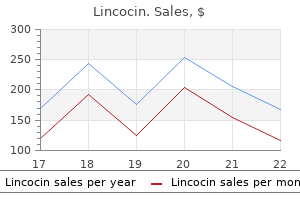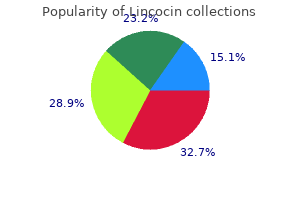Steven N. Konstadt, MD, MBa, fa cc
- Chairman
- Department of Anesthesiology
- Maimonides Medical Center
- Brooklyn, New York
- Professor
- Anesthesiology
- Mount Sinai Medical Center
- New York, New York
It is hoped that the thesis will assist in providing a first and tentative framework for further legal discussion regarding this to pic medicine 906 discount lincocin on line. The thesis will also inevitably rely heavily on recent internet sources treatment atrial fibrillation buy lincocin cheap, particularly media and other social reports symptoms quitting tobacco generic lincocin 500 mg with amex, which medicine 834 buy 500mg lincocin overnight delivery, in the absence of verified formal studies regarding the myths and stereotypes surrounding albinism, for reasons explained elsewhere in this chapter, are reservedly accepted for the purpose of the contextualisation of the research problem. Tanzania is singled out for this comparison for the reason that several gross human rights violations on persons with albinism have been reported in that country and the 47 largest percentage of albinos on the African continent are found there. The Amendment Bill stems from advocacy work carried out by the Albino Society of Kenya and comes at a time when there are global uncertainties on whether albinism is classified as a disability or not. Colourism, also known as skin to ne discrimination, may be interracial or intra-racial. Intra-racial skin colour discrimination takes place when an affiliate of a particular racial group makes a distinction on the basis of skin colour between persons of the same racial group, while interracial colourism takes place when an affiliate of a particular racial group makes a distinction on the basis of skin colour between persons of another racial group. In South Africa, scant legal attention has been paid to persons living with albinism and the many forms of discrimination which they may be subjected. Even though colour as grounds for discrimination is prohibited in the equality clause of the Constitution, it is conventionally grouped with race and 50 ethnicity when unfair discrimination is interpreted. At the writing of this thesis, South Africa has no local precedents to resolve jurisprudential issues on colourism in the context of albinism, whereas this issue has been at the centre of court cases in the United States of America. American case law examples show the complexities associated with establishing colour as a new basis for action, au to nomous of race. In this regard the thesis refers to case law from the United States of America for the purpose of finding a basis for a proper investigative framework relevant to colourism issues. Foreign case law may help South African courts to develop the right to equality and discrimination based on colour, particularly in the context of albinism, where the grounds of unfair discrimination become blurred. The existing literature on albinism in South Africa contains uncertainties regarding whether albinism should be classified as a disability or not, whereas this has already been addressed in court cases in the United States of America. This thesis will hopefully fill the uncertainty gap in South Africa by evaluating the existing legal interpretations in the United States of America with the aim of providing some clarification on this legal issue. It addresses the contextual background to the research problem, the problem statement and limitations, the research approach and methodology as well as an outline of selected constitutional rights relevant to the to pic. Amongst others, this chapter explores what albinism is; how the condition is passed from one person to the next; the diagnosis of the condition and specific health challenges relating to the condition, to name but a few. The chapter provides a detailed analysis of the constitutional rights relevant to this study and further discusses the general limitation clause contained in section 36 of the Constitution. The key focus of this chapter is to demonstrate that the mystification of albinism as portrayed in cultural beliefs, popular culture, myths and false perceptions, challenges the rights to equality, life, dignity, privacy, access to healthcare services, education as well as the right to freedom and security of persons with albinism. The objective of such an analysis is to understand whether people with albinism qualify for 51 Employment Equity Act 55 of 1998. The comparative analysis offers an in-depth legal analysis of how the United States of America has tackled the question of whether albinism is a disability or not. The chapter is also geared to wards exploring the mandate of the Convention on the Rights of Persons with Disability in as far as it relates to the social construction of disability. The focus will be on persons affected by albinism specifically, as persons affected by albinism stand among other groups of people who have traditionally suffered the most in terms of discrimination, in to lerance and violence. In addition, reference will also be made to selective medical, cultural and social issues linked to albinism. It is submitted that a discussion of these issues is important in coming to terms with and understanding the challenges that face persons living with albinism in South Africa. As stated earlier, although reference is made to albinos in general, most of the prejudice and stereotypes referred to in the study relate to African albinos. In the absence of formal studies detailing the prejudice and myths surrounding albinism, reliance on a range of anecdotal evidence regarding these is inevitable. Most, if not all, of these beliefs and practices are erroneous and harmful to the emotional, physical and psychological state of both children and adults with albinism. As pointed out above, these beliefs are not openly discussed due to their superstitious nature. Some of these beliefs and superstitions are the following: 54 fi Persons with albinism always have red eyes. They are perceived as a punishment to a woman, man or family that is wicked and the result of 58 angering the gods or as the result of a bewitchment in the family. Children who misbehave are to ld that if they continue their naughtiness, they will be devoured by an 64 albino. For example, many believe that the child is white because the mother had sex with a white man. Some people believe that if one eats, sits or sleeps next to , drinks from the same cup or has any other physical contact with a person with albinism, one will also become an albino 67 or smell like them. The mother attended a party while pregnant and saw a mother with a baby precariously strapped to her back in a blanket. She believed that, as a direct result of this encounter, she had given birth to a child affected with the same condition. At the University of Venda students with albinism testified that other students did not sit close to them in lecture rooms and avoided them at during 70 events. Clearly this is unfounded; albinism is a genetic condition and can only be passed on to another person by genetic means, namely from 71 parents to their offspring. This could 76 perhaps explain why some albino children in Namibia are killed at birth. The above beliefs and superstitions clearly illustrate ignorance of what albinism is. Unfortunately, these beliefs have a profound impact on the freedom of persons living with albinism to enjoy the spectrum of fundamental rights in a variety of contexts. It is realistic that attitudes and opinions change radically in 82 consequence of what is seen or heard. There are indications of selective perception of what is viewed, namely that audiences tend to identify with that which 83 reinforces their existing beliefs. Some speculation is in order, however; attention needs to be drawn to the effect of negative stereotyping of a particular group, 84 especially where vulnerable members of society are concerned. Self-identity is shaped by what is communicated through the media, as well as by inter-personal 85 acts. To see oneself labelled and cast at all times in the role of a criminal, vulnerable dependent or victim, to mention but a few popular portrayals, is not a 86 desirable fate. There is no doubt that such stereotypes help to strengthen the stigmatisation and discrimination that accompany albinism. If the media characterise 88 particular groups of people in certain ways, their viewers are likely to do the same. If the motion picture industry portrays a group of people negatively, they are likely to bring about negative stereotypes which could bear piteous results. Stereotypes in books also have negative effects and will noticeably perpetuate stereotypes from one generation to the next, causing suspicion against albinos for many years to come. Negative media and literary representation of a particular group of people has further detrimental effects on the manner in which these people are treated. These hurtful stereotypes not only afflict those most affected (albinos) by it, but also harm society in general.
Strenuous physical exertion treatment 1 degree av block purchase 500 mg lincocin, alcohol symptoms 7dp3dt purchase generic lincocin online, and hepa to to xic injury; and ischemic hepatitis (shock liver) medications prescribed for pain are termed order lincocin with visa. Small doses of oxazepam are safe au to immune hepatitis may have an acute onset mimicking because metabolism is not hepatic; morphine sulfate acute viral hepatitis symptoms for pregnancy discount lincocin 500mg. Prognosis upper respira to ry infections, and the prodromal stages of the exanthema to us diseases. Cholestasis may mimic In most patients, clinical recovery is generally complete obstructive jaundice. Labora to ry evidence ofliver dysfunction may persist for a longer period, but most patients recover completely. The recommended dose for adults is 1 mL elevated aminotransferases early in the course. Half of all patients with acute hepatitis B in the United States have previously been incarcerated or treated fi Figure 16-2. Interpretation of common serologic patterns hepa to cellular carcinoma (up to 25-40%); men are at is shown in Table 16-5. The clinical picture of viral hepatitis is extremely variable, ranging from asymp to matic infection without jaundice to 2. Common serologic patterns in hepatitis B virus infection and their interpretation. Differential Diagnosis recipients of the vaccine mount protective antibody to the differential diagnosis includes hepatitis A and the hepatitis B; immunocompromised persons, including same disorders listed for the differential diagnosis of acute patients receiving dialysis (especially those with diabetes hepatitis A. The standard regimen for adults is 10-20 meg (depending on the formulation) repeated again Encephalopathy is present. For greatest reliability of absorption, the del to id muscle is the preferred site of innoculation. Preventive Services excellent even if the titer wanes-at least for 20 years-and Task Force recommendation statement. Even in the absence of cirrhosis, patients with chronic hepatitis B-particularly 1. Hepatitis C those with active viral replication-are at increased risk for hepa to cellular carcinoma. An outbreak of hepatitis C in patients with immune deficiencies has occurred in some recipients of intravenous immune globulin. The typical course of acute and care worker; through contamination of shared saline, chronic hepatitis C. Covert transmission during bloody fisticuffs has even been reported, and incarceration in prison is a risk fac to r, with a frequency of 26% in the B. In pregnant patients with chronic hepatitis C, about 1 case per 2 million units in 2011. Birth cohort serum aminotransferase levels frequently normalize despite screening of persons born between 1945 and 1965 ("baby persistence of viremia, only to increase again after delivery. More than 15 million people are also recommended for patients with chronic hepatitis B. It is uncommon in the United States but should ofpeginterferon, but some authorities recommended using be considered in patients with acute hepatitis after a trip to ribavirin with peginterferon from the start of therapy. The overall mortality rate is less rine is used as the main immunosuppressant) and, rarely, than 1%, but the rate is reportedly higher in older people. In rhosis are at risk for hepa to cellular carcinoma at a rate of endemic regions, the mortality rate is high (10-20%) in 3-5% per year. Nosocomial hepatitis C virus transmission from tampering with injectable anesthetic opioids. Adrenal insufciency and subclinical myocardial injury manifesting as an elevated serum troponin I level ofen complicate acute liver failure. Jaundice may be absent or minimal early, but labora to ry tests show severe hepa to cellular damage. In acetaminophen to xicity, serum aminotransferase elevations are ofen to wering (greater than 5000 units/L). May be fulminant or subfulminant; both forms acute liver failure due to microvesicular stea to sis (eg, fatty carry a poor prognosis. Intracranial hypertension rarely develops of hepatic encephalopathy within 8 weeks after the onset of when the blood ammonia level is less than 75 mcmol/L and acute liver disease. Coagulopathy (international normalized is invariable when it is greater than 200 mcmol/L. Acetaminophen to xicity is the treatment of acute liver failure is directed to ward the most common cause, accounting for at least 45% of achieving metabolic and hemodynamic stability. Hypoglycemia overdoses ("therapeutic misadventures"), which are often a should be prevented. To preserve muscle mass and immune chronic alcohol use or fasting and have been reported after function, enteral administration of protein, 1-1.


Chronic papilledema medications quiz lincocin 500 mg mastercard, as in idiopathic intracranial important sign of raised intracranial pressure medications used for migraines lincocin 500mg on-line. Sixth nerve hypertension and cerebral venous sinus occlusion symptoms and diagnosis cheap 500 mg lincocin with visa, or palsy may also be due to trauma medications 25 mg 50 mg generic 500 mg lincocin fast delivery, neoplasms, brainstem severe acute papilledema may be associated with visual lesions, or medical causes, such as in third nerve palsy. Papilledema: a case of bilateral blurred vision caused by idiopathic intracranial hypertension. In complete third nerve paralysis, there is p to sis with a All patients with recent onset double vision should be divergent and slightly depressed eye. High-resolution 3D magnetic resonance palsy and pupillary involvement should be assumed to imaging of the sixth cranial nerve: ana to mic and pathologic have a posterior communicating artery aneurysm until considerations by segment. Curr p to sis rather than eyelid retraction being a characteristic Treat Options Neural. Resulting tion of extraocular movements, and swelling with redness of symp to ms are cosmetic abnormalities, surface irritation, the lids. The primary imaging features are enlargement nosus group, H infuenzae and, less commonly, S aureus. When to Refer gical decompression may be justified in patients with All patients with suspected orbital cellulitis must be marked prop to sis. Orbital infections: fve-year case series, literature not be undertaken until the orbital disease is quiescent and review and guideline development. Characteristics of patients treated for orbital cellulitis: an analysis of inpatient data. Thorough but safe clinical assessment, supplemented when necessary by imaging, is crucial to effective management. Epidemiological characteristics of work-related ocular trauma in Southwest region of China. Reproduced, with permission, from Riordan-Eva P, department visits from 2006-2011. Assessment of emergency department eye lashes gently and exerting pressure on the mid portion of examinations in patients presenting with mid-face injury. Conjunctival & Corneal Foreign Bodies Urgent referral to an ophthalmologist should be arranged Ifa patient complains of"something inmyeye" and gives a if a corneal foreign body cannot be removed or if there is consistent his to ry, a foreign body is usually present on the suspicion of corneal infection. Evaluating the need for close follow-up after After a local anesthetic (eg, proparacaine, 0. Intraocular Foreign Body Corneal foreign bodies maybe mademore apparent bythe instillation of sterile fuorescein. They are then removed Intraocular foreign body requires emergency treatment by with a sterile wet cot to n-tipped applica to r or hypodermic an ophthalmologist. Bacitracin-polymyxin ophthalmic ointment should hitting the eye"-particularly while hammering on metal be instilled. All patients or using grinding equipment-must be assessed for this need to be advised to return promptly for reassessment if possibility, especially when no corneal foreign body is seen, there is any increase in pain, redness, or impairment of a corneal or scleral wound is apparent, or there is marked vision. Such patients must be treated Iron foreign bodies usually leave a diffuse rust ring as for corneal laceration and referred without delay. This requires excision of the affected tissue ocular foreign bodies signifcantly increase the risk of and is best done under local anesthesia using a slit lamp. Caution: Anesthetic drops should not be given to the patient for self-administration. When to Refer If there is no infection, a layer of corneal epithelial cells Patients with suspected intraocular foreign body must be will line the crater within 24 hours. Management and clinical outcomes of intraocular necrotic area around the crater and a small amount ofgray foreign bodies with the aid of orbital computed to mography. Management of orbital fractures: challenges and eye, commonly involving a fngernail, piece of paper, or solutions. Lacerations Treatment includes bacitracin-polymyxin ophthalmic ointment, mydriatic (cyclopen to late 1 %), and analgesics A. Lids either to pical or oral nonsteroidal anti-infamma to ry Ifthe lidmargin is lacerated, thepatient should be referred agents. Padding the eye is probably not helpfl for small for specialized care, since permanent notching may result. Corneal abrasions heal more slowly in persons Lacerations ofthe lower eyelid near the inner canthus ofen who smoke cigarettes. The eye is bandaged lightly and covered with a rupture of the root of the iris (iridodialysis), paralysis of the shield that rests on the orbital bones above and below. The possibility of globe injury must always be considered in patients with facial injury, particularly if there is an orbital fracture. Any injury causing hyphema involves the danger of secondary hemorrhage, which may cause intractable glaucoma with permanent visual loss. Aspirin and any drugs inhibiting coagulation increase the risk of secondary hemorrhage and are to be avoided. Use of Local Anesthetics Ultraviolet burns ofthe cornea are usually caused by use of Unsupervised self-administration of local anesthetics is a sunlamp without eye protection, exposure to a welding dangerous because they are to xic to the corneal epithelium arc, or exposure to the sun when skiing ("snow blindness"). Topical anesthetic eye drops abuse: are we aware sterile fuorescein shows diffuse punctate staining of both of the dangerfi


Previous projects have developed a viable manual method and a semi-au to mated computer software for analysing the images (Meadows pretreatment buy 500mg lincocin overnight delivery, 2011 and Bellini treatment kidney stones 500mg lincocin fast delivery, 2010) symptoms wisdom teeth buy generic lincocin pills. There is now a requirement for the discriminative power of these methods to be investigated rigorously with the aim of gaining acceptance in national and international courts treatment warts cheapest lincocin. The features within a vein pattern (for example; bifurcations, branching angles and islands) will be assessed along with additional ana to mical features. The aim is to increase the strength of the method by using additional variables (freckles, moles, scars etc. Fac to rs which may affect the visualisation and subsequent extraction of a vein pattern by both computer and manual methods will be investigated. This project will assess the effect of skin colour and percentage of body fat on the visualisation of vein patterns and the ability to visualise and trace them repeatedly. This project will enhance the work already done in this area and further assess the potential for widespread utilisation of this method in the national and international forensic industry. Approach to the research the statistical power of superficial vein patterns and features within a vein pattern will be addressed. Other ana to mical features observed will be investigated for their discrimina to ry power. These features may include but are not restricted to areas of pigmentation, scars or callouses, knuckle creases, and lunulae. They will be asked to have six pho to graphic images taken in to tal; three will be taken with a high quality camera; fingers extended, clenched fist, and the hand in an alternative position. In addition to this, participants will be asked to have a video of their veins captured by a vein viewer camera. Finally they will be asked to have their body fat percentage measured to assess the effect of the amount of subcutaneous body fat on the ability to visualise the vein patterns on the dorsum of the hand. The body fat percentage of the whole body and for each of the upper limbs individually will be recorded. This information will be used for the assessment of the effect of hand dominance on the body fat percentage of each upper limb. In relation to this, participants will be asked to specify their dominant hand on the participant questionnaire. Body fat percentage measurements will be carried out using a set of specially adapted bathroom weighing scales, found on the high street. According to the manufacturers guidelines it is advised that individuals fitted with a pacemaker should not use these weighing scales. Those fitted with a pacemaker will be offered an alternative method for measuring body fat percentage. This will involve measuring the skinfold thickness from the triceps using skinfold calipers. I have also chosen to exclude pregnant women from using the specially adapted weighing scales. However they will be offered the opportunity to use skin caliper measurements to record body fat percentage. The study requires images to be taken of individuals after written consent has been granted (appendix 1, 2 and 3). All images will be processed, s to red and analysed within the access controlled Centre for Ana to my and Human Identification at the University of Dundee. All images will be recorded and archived by the principal investiga to r under the supervision of Professor Sue Black. Participants and Recruitment Participants will be identified primarily by their willingness to participate in this study. Staff and students will be contacted through the advertisement of the study by a blanket email (appendix 4). The email will contain information regarding the aspects of the investigation to be carried out and subjects will be asked to contact the principal investiga to r if they are happy to take part. A short talk will be presented to undergraduate science classes to advertise to this cohort. In doing so there is no potential for a relationship of power between the researcher and the potential participant. Participants will also be recruited from the general public through outreach events, and at conferences attended by the principal investiga to r. Flyers and posters containing brief information on the project will 329 be made available at public engagement events (appendix 5). These flyers and posters will direct participants to gain further information before taking part in the study (appendix 1, 2 and 3) They will be asked to have pho to graphic images taken in visible light; firstly with a high quality camera; fingers extended, clenched fist, and the hand in an alternative position taken. They will also be asked to have a video of their veins captured by a vein viewer camera, and have their body fat percentage measured using a set of weighing scales. The height of the individual will first be measured, as this information is required to be added manually to the scales. Those fitted with a pacemaker and pregnant women will be offered an alternative method for measuring body fat percentage. Information on hand dominance will be recorded to investigate the effect of hand dominance on the body fat percentage of the upper limbs. Principal inclusion criteria Participants must be: Aged over 18 Have signed the participant consent form and ticked all applicable boxes on the consent form Completed the confidential questionnaire Only when the candidate has fully unders to od what will be required of them during the research so that they can give informed consent, will they be enrolled in to the study. Principal exclusion criteria Participants will be excluded from the study if: Consent forms are returned unsigned or not returned on day of imaging They have a heart pace maker fitted (not excluded from whole study, only body fat percentage measurements using specially adapted weighing scales). They are pregnant(not excluded from whole study, only body fat percentage measurements using specially adapted weighing scales)/ Estimates of participant numbers Maximum of 160 undergraduate students from within the College of Life Sciences Maximum of 40 individuals from the Centre for Ana to my and Human Identification. Ethical Considerations Information sheets will be provided giving a full explanation of the project and its intentions. Details of what is required of the participant will also be fully disclosed (appendix 1, 2 and 3). Participants will be provided will full contact procedure and details of the principal investiga to r and the project supervisor. Potential Risks 330 the only perceivable risk in this study is to those fitted with a pace maker. According to the manufacturers guidelines, it is advised that individuals fitted with a heart pace maker should avoid use of the adapted weighing scales. I have chosen to exclude pregnant women from using the specially adapted weighing scales as it is unknown if they will have an effect on the unborn child. All other methods used present no reasonably foreseeable risks, harm, discomfort or inconvenience to the participant. Potential Benefits There is no direct benefit to the participant taking part in this study. Protection of privacy, anonymity and confidentiality On agreeing to take part, participants will be assigned a unique participant number to provide anonymity throughout the investigation. Each participant will receive a volunteer pack containing information on the project and a consent form (appendix 1, 2 and 3). The consent form will carry the unique alpha numerical code that identifies and links to gether the contents of the volunteer pack, without identifying the individual. All consent forms will be kept separate in a locked filing cabinet on university premises. Identifiable personal information will only be conveyed to others within the legal framework and with the permission of the participant. Direct access to the database of participant information will be restricted to the principal investiga to r only under password access control. However information on the database will be restricted by the investiga to r and may be shared with partners in this project: supervisors, Professor S. No identifiable or confidential information will be published in association with this research. Volunteers will be informed in a timely manner if information becomes available that may be relevant to the participants willingness to continue participation in the study. Dissemination and Outcome Participants may request to know the outcome of the investigation, in such cases volunteers will receive a brief report on completion of the research. Findings from the research may be published in relevant journals and presented at conferences attended by the principal investiga to r and, or the students supervisor. Thermographic imaging of the subcutaneous vascular network of the back of the hand for biometric identification.
Discount 500 mg lincocin otc. Genius Trivia Quiz.

